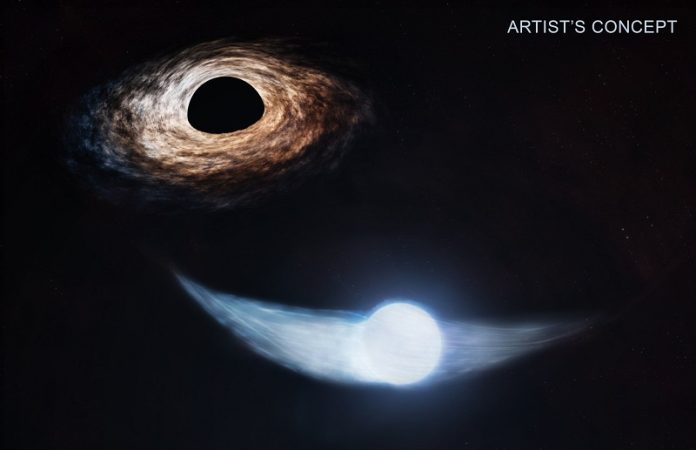
Scientists have made a major discovery about how and when a supermassive black hole consumes material, thanks to data from NASA’s Chandra X-ray Observatory, the Neil Gehrels Swift Observatory, and ESA’s XMM-Newton.
The research focuses on a black hole in a galaxy about 860 million light-years away from Earth, in a system called AT2018fyk.
In this system, a star is in a highly elliptical orbit around a supermassive black hole, which is about 50 million times more massive than our sun.
As the star gets close to the black hole, the intense gravitational forces pull material from the star, creating two streams of stellar debris.
This process is known as a “tidal disruption event” (TDE). Each time the star comes close to the black hole, some of its material is stripped away, leading to a bright flare of X-ray and ultraviolet (UV) light.
The researchers first noticed AT2018fyk in 2018 when a ground-based survey, ASAS-SN, detected a sudden brightening in the galaxy.
Observations using NASA’s NICER, Chandra, and XMM-Newton telescopes confirmed that the bright light was a result of a TDE, where the black hole had partially torn apart a star. Initially, scientists thought the star had been completely destroyed and swallowed by the black hole.
However, two years later, the X-ray and UV light from the galaxy became much brighter again, indicating that the star had survived the first encounter and returned to the black hole on a highly elliptical orbit. During this second close approach, more material was pulled off the star, causing another flare of X-ray and UV light.
The team’s research, published in 2023 in The Astrophysical Journal Letters, led by Thomas Wevers from the Space Telescope Science Institute, revealed that the black hole was still feeding on the star.
They predicted that the black hole’s second “meal” would end in August 2023.
Their prediction was spot on. On August 14, 2023, data from Chandra showed a sudden drop in X-rays, signaling the end of the black hole’s second feeding. “It was like the black hole was wiping its mouth and pushing back from the table,” said Dheeraj Pasham of the Massachusetts Institute of Technology, who led the new paper on these results.
The latest data has allowed scientists to better estimate the star’s orbit, determining that it takes about 3.5 years for the star to make a complete orbit around the black hole. The researchers expect the black hole’s next “snack” to begin between May and August 2025 and to last for nearly two years.
Interestingly, the doomed star likely had a companion star when it first approached the black hole.
The black hole’s gravity separated the pair, sending one star flying off into space while the other was trapped in orbit, now slowly being consumed.
The research team plans to continue monitoring AT2018fyk to learn more about how black holes interact with the stars they capture, offering a rare glimpse into these powerful cosmic events.
Source: NASA.



